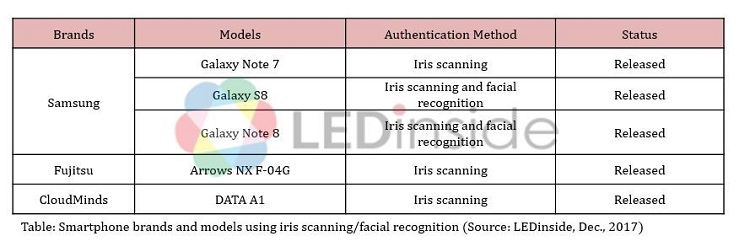Major smartphone vendors like Samsung and Apple have been making improvements regarding unlocking devices beyond password-based methods, resulting in the rapid development of biometrics recognition in smartphones. In addition to smartphones, biometrics authentication methods will also be used in tablets and wearable devices. Particularly, iris scanning and facial recognition require infrared (IR) LED components, which will boost the growth in this niche LED market. This will be a new battlefield and a chance of transformation for Taiwanese LED components suppliers.
Unlock your phone with a glance! The principles and applications of iris scanning
Iris recognition is based on the unique iris patterns of individuals, thus is previously used mostly in military devices and other systems with high security requirements. Iris authentication methods have a number of advantages. First, iris recognition is safe since individuals all have unique iris patterns. Even two eyes of a person or eyes of twins have totally different patterns. Second, the patterns are created during the 3rd to 8th month of gestation, and then remain stable for the whole life. In addition, iris images can be captured without direct contact of the eyes, making the authentication process easier and safer.
Adding iris scanning capabilities to smartphone was initiated by Samsung Note 7. With the prevalence of smart applications and mobile payment, using smartphones for ID authentication is convenient and efficient, but meanwhile, requires higher level of privacy and security. Current, iris scanning is not yet common in smartphones, but is very likely to be increasingly adopted in the near future because it is the safest method available now, and the price will soon drop to what the public can afford.
However, technical restraints still remain for iris recognition at current stage, including difficulties in image capturing, need for delicate capturing equipments and suitable light source, the influences of eyelashes and eyelids, pupil dilation, and the reflection of glasses when scanning in direct sunlight, etc.
Major LED companies expand investment, IR LED market will see explosive growth
Iris scanning is expected to bring a new round of investment in LED industry. Currently, IR LED components are mainly used in surveillance cameras and sensors, LED products with a wavelength of 850nm and 940nm are the major specifications. In response to the demand for iris scanning and facial recognition applications, LED component makers race to develop 810nm LED products to lay foundation in the market. Currently, leading players of global IR LED market are OSRAM, Taiwan’s Epistar, and Chinese manufacturer San’an Optoelectronics. All three have expanded investment in this area.
According to 2018 Infrared Sensing Application Market Report by LEDinside, a division of TrendForce, the market value of IR LED for iris scanning and facial recognition is projected at USD$300 million in 2021.
In the iris scanning/facial recognition industry chain, upstream sector includes IR LED components, algorithm/software, and IR cameras. Only a few manufacturers produced IR LED in the past. But considering that IR LED is the core component of recognition technologies, IR LED market has been expanding and will emerge as a new blue ocean with high gross margin.
However, IR LED fabrication requires AlInGaP LED manufacturing equipment, adding to the technical barriers at current stage. In addition, when LED lighting products use secondary optics to modify spatial distribution, IR RED applications do not need that to define the light patterns. But technical bottlenecks exist regarding making high power LED applications with smaller beam angles. Other critical issues for IR LED market also remain, for instance, algorithm, software and authentication systems all involve complicated development process, and downstream companies are still in early stages of application development.
As biometrics recognition technology advances, the demand will keep increasing, resulting in more dynamic and diverse applications of IR LED in the future. This explains why manufacturers are now actively laying the foundation in the market to explore more opportunities.












